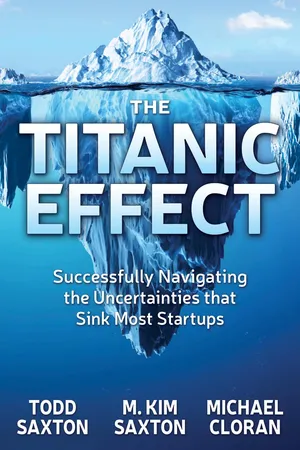
eBook - ePub
The Titanic Effect
Successfully Navigating the Uncertainties that Sink Most Startups
This is a test
- English
- ePUB (mobile friendly)
- Available on iOS & Android
eBook - ePub
The Titanic Effect
Successfully Navigating the Uncertainties that Sink Most Startups
Book details
Book preview
Table of contents
Citations
About This Book
- Reveals the challenges entrepreneurs face, and offers a toolkit for them to navigate around sources of failure
- Shares the authors' wisdom from decades of starting, advising, and investing in hundreds of startups to show entrepreneurs how to navigate the uncertainty that can sink their ventures
- Informs early-stage investors about the hidden debts startups may have incurred which can sink them and waste their investor dollars
- Provides a tool for entrepreneurs and their stakeholders to measure and manage hidden non-financial debts
- Goes beyond the glamor of entrepreneurship portrayed in dozens of books to unveil navigation plans and avoid startup failure
- In 2016, nearly $100 billion in Venture Capital and Angel funding was invested in startups, with a failure rate of over 70%. The Titanic Effect helps investors understand why these startups fail and offers a mechanism to prevent such failure.
- Reveals the true reasons behind the sinking of the Titanic and why the catastrophic losses occurred
- Written in the style of Steven Johnson ( How We Got To Now, Future Perfect ) and Daniel Pink ( Drive, A Whole New Mind ).
Frequently asked questions
At the moment all of our mobile-responsive ePub books are available to download via the app. Most of our PDFs are also available to download and we're working on making the final remaining ones downloadable now. Learn more here.
Both plans give you full access to the library and all of Perlego’s features. The only differences are the price and subscription period: With the annual plan you’ll save around 30% compared to 12 months on the monthly plan.
We are an online textbook subscription service, where you can get access to an entire online library for less than the price of a single book per month. With over 1 million books across 1000+ topics, we’ve got you covered! Learn more here.
Look out for the read-aloud symbol on your next book to see if you can listen to it. The read-aloud tool reads text aloud for you, highlighting the text as it is being read. You can pause it, speed it up and slow it down. Learn more here.
Yes, you can access The Titanic Effect by Todd Saxton,M. Kim Saxton,Michael Cloran in PDF and/or ePUB format, as well as other popular books in Business & Entrepreneurship. We have over one million books available in our catalogue for you to explore.
Information
CHAPTER 1:

INTRODUCTION
“And as the smart ship grew In stature, grace, and hue, In shadowy silent distance grew the Iceberg too.”
“Start me up.”
It was a cool but clear day in April of 1912 when the Titanic set sail from Southampton, England, bound for the United States. Close to midnight four days later, the Titanic encountered the destructive mass of an iceberg and began its descent into the icy depths of the Atlantic. It was still far from the New York Harbor that the White Star Line and its passengers had envisioned as the ultimate destination when they launched. Over half of these passengers were lost, along with the majority of the crew.
The Titanic has become emblematic of epic failure. Its tale has inspired countless stories and movies portraying the disastrous implications of thinking you are “too big to fail.” Despite all the story’s retelling, though, most people still have never heard about the series of small decisions that culminated in this calamity.
The White Star Line was dealing with a lot of uncertainty in building and launching the Titanic. Could the company overcome a history of technical problems and tragedies with ships? How big was too big for an ocean liner? Could the shipyard build the Titanic to standard while building two other similarly sized ships nearly simultaneously? Could the staff necessary to crew an engineering marvel also serve as able-bodied seamen for other tasks? How would a product designed for the wealthy and famous first-class passengers also serve the needs of the high-volume, third-class passengers? What accommodations for luxury and aesthetics could the company adopt without sacrificing safety? The owners and builders had to make many choices without full knowledge of the consequences of these decisions. Unfortunately, the consequences were fatal.
Navigating uncertainty is the essential task of the entrepreneur. What to build, how to build it, whom to partner with, whom to sell to, and how to fund growth are just a few of the many uncertainties entrepreneurs face. Each decision on these dimensions creates unintended consequences—ramifications most entrepreneurs and their supporters are not able to anticipate that have an impact on the startup’s viability. These unintended consequences create constraints, obligations, perceptions, and expectations that can limit success or even sink the emerging startup. We call these hidden consequences of navigating uncertainty hidden debts.
Indeed, like many failed ventures, the story of the Titanic is one of an accumulation of hidden debts that might as well have been little icebergs battering holes into the hull of the ship before she even got close to the big berg. Ultimately, failure came from cumulative effects of those little debt icebergs—or “debtbergs” —not the single incident of an unstoppable force meeting an immovable object.
For the Titanic, these hidden debts accumulated in all aspects of the project:
- •the people who financed, built, and operated the ship
- •the diverse needs of the customers who embarked upon that fateful journey
- •the engineering challenges involved in designing and building this large and luxurious vessel
What Are Hidden Debts?
Most of us think of debt in financial terms—how much you owe the bank or other creditors for your mortgage, credit card, or car loan. For the entrepreneur, financial debt may be money the company borrows if she is able to get a bank loan. These debts are fairly easy to identify and assign a value. They certainly are important to manage, and if you can’t pay them back, it can create trouble!
However, in the startup context, debt often takes on other, less tangible forms. Like an iceberg, the visible component of debt above the surface masks the much larger and more problematic non-financial debts that lurk beneath the surface. When navigating uncertainty, identifying the tradeoffs and assessing the results of key decisions are difficult. As such, we define hidden debts as the unanticipated consequences of navigating uncertainty. The uncertain nature of entrepreneurship means that founders might not be able to identify these debts easily or know how to avoid or repay them. Taking on these debts may be necessary and can buoy a startup—or sink it. Our hope is to help entrepreneurs and their supporters identify where these hidden debts might lie, and help them navigate successfully through the Oceans of debtbergs that await.
Where Do Hidden Debts Come From?
Even though most people haven’t heard of them, hidden debts are not new; many have historical precedent. They have haunted entrepreneurs for centuries—and founders as auspicious as President Abraham Lincoln fell into traps of hidden debt with his failed grocery store venture (see Chapter 3).
The people involved with starting a company, from the founders to the investors and advisors to the first employees, are one source of hidden debt. The early team probably won’t have everything it needs to launch the company properly, but it proceeds by incurring a hidden debt in skills and resources that it will need to make up later.
After human-related hidden debts, we talk about marketing and technical choices as areas where the startup must get by on less than it really needs. The latter area might not be unfamiliar to you: the notion of technical debt as the early choices or mistakes tech entrepreneurs make that end up limiting the scalability or growth potential of their ventures has been common parlance in the IT sector for some time. See Chapter 2 for our origin story about how the authors’ discussions of technical debt led to our broader narrative regarding hidden debt.
With the popularity of the Lean Startup and rapid experimentation and iteration, entrepreneurs worldwide have embraced the pivot—the notion that, in the early stages, founders should experiment and redirect rapidly based on market feedback.1 There is much to be said for getting customer reaction and market feedback before going all in on the direction of the company. However, each pivot also creates a series of hidden debt icebergs that a startup must navigate. These debtbergs can ultimately result in a Lean Startup joining the countless carcasses of venture concepts that, like the Titanic, riddle the floor of the economic ocean.
For the Titanic, hidden debts manifested in multiple ways. For example, you might not know these tidbits:
- •White Star Line, the company that owned the Titanic, changed builders prior to building the Titanic and its sister ships at the insistence of a major investor.
- •The Titanic did not meet design specifications in its key bulkheads so that it could accommodate a larger and more luxurious dining room for wealthy travelers.
- •The rivets used in the exterior parts of the ship were of substandard materials.
- •The crew was sadly lacking in able-bodied seamen who knew how to load lifeboats.
These elements and more set the stage for the Titanic’s sinking, which had ripple-through effects on maritime law and safety practices for decades. These systemic changes persist even today. In the startup world, we have seen similar ripple-through effects. For example, the JOBS (Jumpstart Our Business Startups) Act of 2012 helped small and new businesses overcome uncertainty in many ways, but also created new sources of uncertainty and hidden debts for some startups.
Foreshadowing

Fourteen years before the sinking of the Titanic, author Morgan Robertson penned the novella Futility. In this novel, a massive ship called Titan, largest of its kind, collided with an iceberg and sank in the month of April. While many lauded Robertson for his clairvoyance, he simply noted that increasing ship size and traffic in the iceberg-ridden shipping lanes made such an event increasingly likely. Still, the ship’s name does make the coincidence downright eerie.2
Why Did We Write this Book?
You may have already noticed that this is not a feel-good book about being a rock star entrepreneur and finding the key to vast riches. If we wanted a tale of inspiration, full of promis...
Table of contents
- Cover
- Title
- Copyright
- Dedications
- Table of Contents
- Foreword
- Preface and Acknowledgements
- Chapter 1: Introduction
- Chapter 2: Why the Titanic and Icebergs
- Chapter 3: The Human Ocean
- Chapter 4: The Marketing Ocean
- Chapter 5: The Technical Ocean
- Chapter 6: Core Concepts of Strategy
- Chapter 7: The Strategy Ocean
- Chapter 8: The Iceberg Index
- Chapter 9: Setting Sail
- About the Authors
- Glossary